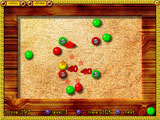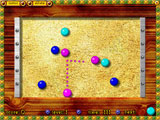Physics in Casual Games, Caramba Deluxe
The great thing about physics games is how marvelously intuitive they are. Everyone is familiar with motion: how things bounce, glide, stack, fall, and so on. Physics is universal. In fact, I’ve even seen chickens predicatively track the trajectories of thrown rocks (I grew up with llamas, goats, and chickens about. No kidding).
Casual games are computer games aimed at a mainstream, popular market. They are games that literally anyone should be able to sit down and play. It follows that physics-based games would make great casual games. After all, the rules of motion are universal. In fact, there have been several physics-based games released for the casual market. I’ll talk about some others later, but one such recent title is Caramba Deluxe by Zylom.
Caramba Deluxe is best described as billiards meets match-3. You knock balls around and clear the game board by colliding three or more like-colored balls in the same shot. As with any billiards game, angles are everything.


(Caramba Deluxe Game Screenshots)
Caramba Deluxe is impressive in that it’s an extremely accessible implementation of a very elegant design. The aiming guideline is always present so there’s never any question about where your ball will go. It’s very easy to fire off a few balls and immediately grasp how the game works. Shot power is timed, though, which is where one element of player skill comes into play. The other skill aspect is the concept of lay, which is how the board will end up after you fire the shot. Later levels require you to think several moves ahead to pass the level with a good score.
The game has bonus trophies for passing each stage with a minimum score (combos improve your score), finishing the level under a certain time, and firing a minimum number of balls. Complexity is added by introducing new colors, “dead” colors that don’t require matching, irregular level shapes, balls that require multiple matches to clear, and metal walls that limit where you can shoot balls from.
Despite the great attempts at variety the game’s pacing does start to wear thin after awhile. This is a shame, because the core of the game is so solid. On the portals Caramba poked into the Top 10 at RealArcade for a single week before vanishing. I feel like if they had held onto development for just a little longer they could’ve ended up with a more robust and varied player experience. Perhaps Zylom overdid the simplicity of their design. I sincerely hope the game’s moderate success doesn’t deter other casual developers from embracing physics, though–physics such a great tool for game design.
It’s always hard to second-guess a game’s design. What would you have done differently?
Related Posts:
- Crayon Physics Deluxe is Out!
- A Chorus of Physics Games: Bounce Symphony
- List of Physics Games
- Peggle! Funny Word, But Fun Game?
A Classic: Bridge Builder by Chronic Logic
I would seriously be surprised if Bridge Builder was new to anyone. It really made the Internet paste-around tour when it was first released in December of 2000. The original Bridge Builder game is no longer officially available, apparently due to legal collisions with the name. The series lives on, though, as Pontifex and Pontifex 2.
So what is Bridge Builder? The name says it all: you build bridges. The trick is that you need to build structurally sound bridges with limited resources. The goal of each level is to cross a span and then run a hefty train over your freshly-built trestle. Proper engineering is crucial: An understanding of triangles and support structures will go a long way.


(Bridge Builder Game Screenshots)
The UI is a little clumsy, but the solid physics engine underpinning the simulation makes up for any shortcoming in presentation. Key to any game like this is a predictable, reliable physics engine. The same bridge needs to behave the same way every time in a very deterministic fashion. Chronic Logic did a great job with this. The game is even robust enough to allow for hardcore design competitions.
Bridge Builder also does a great job communicating the status of your structure during the simulation/test mode. Bridge segments are color-coded by the amount of stress they’re under. It’s an elegant way to show you which areas of your bridge are robust and which are likely to fail.
Chronic Logic no longer officially supports the original demo, but you can download it right here. If you’ve never seen the game before, or are simply looking to relive some old memories, download the game and give it a whirl!
Related Posts:
- Gish 2 Announced!
- The Beginning
- Gish, The Father of Physics Platformers
- One-Part Tetris, One-Part Physics: Triptych
Amoeball: Hot Single Cell Action
Amoeball is a game I made in my spare time over two years. It began as a simple learning experiment. I was teaching one of our artists, Steve, how to use physics in the development platform we use, Virtools. Within 45 minutes a simple volleyball game was completed, but we played the game itself for a good two hours after that. It was one of those rare times where you spend much more time playing a game than you did actually making it.
From there we decided to slap some art treatment on the game. I added a simple AI and refined the menu a little. The end result is what you see here. It seems simplistic–and really, it is–but give the game 30 minutes of your time playing against a friend. You might be surprised how deep some of the strategies run.
Click on the above screenshots to enlarge. The game is playable online right in your web browser using the Virtools Web Player.
Click here to play the free Amoeball volleyball physics game.
Related Posts:
- List of Physics Games
- The Evolution of an Idea: Rolling Assault
- Interview with Matthew Wegner (Fun-Motion.com)






 My name is Matthew Wegner, and this site is dedicated to physics games.
My name is Matthew Wegner, and this site is dedicated to physics games.